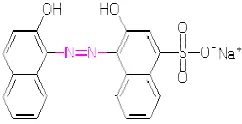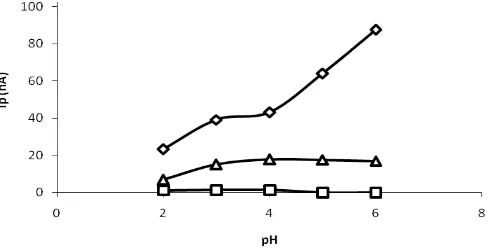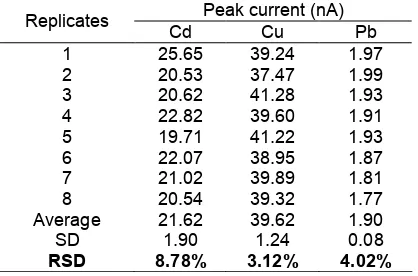SIMULTANEOUS DETERMINATION OF CADMIUM, COPPER AND LEAD IN SEA WATER
BY ADSORPTIVE STRIPPING VOLTAMMETRY IN THE PRESENCE OF CALCON
AS A COMPLEXING AGENT
Deswati*, Hamzar Suyani, Safni, Umiati Loekman, and Hilfi Pardi
Department of Chemistry, Faculty of Mathematics and Natural Sciences, Andalas University, Kampus Unand Limau Manis Padang 25163, Indonesia
Received February 8, 2013; Accepted September 15, 2013
ABSTRACT
A selective and sensitive adsorptive stripping voltammetric (AdSV) procedure for the simultaneous determination of cadmium, copper and lead in the sea water was conducted. The aim of this research is to get optimum condition for simultaneous determination of cadmium, copper and lead. Adsorptive stripping voltammetry has been used for determination of trace amount of Cd(II), Cu(II) and Pb (II) by using calcon as a complexing agent. The parameters studied were variation of calcon concentration, pH, accumulation potential and accumulation time. In this study, the optimum conditions were calcon concentration of 0.6 mM, pH = 4.0, accumulation potential of -0.7 V and accumulation time of 80 sec. At the optimum conditions, the relative standard deviation were 8.78%, 3.12%, and 4.02% for Cd(II), Cu(II) and Pb(II) respectively for eight replicates (n = 8) measurements of 10 μg/L mixed standard solution of Cd(II), Cu(II) and Pb(II). The method was applied to the direct simultaneous determination of Cd(II), Cu(II) and Pb(II) in sea water around Bungus, Padang City. Concentration of Cd(II), Cu(II) and Pb(II) in samples were equal to 1.8 μg/L for Cd(II), 38.6 μg/L for Cu(II) and 0.7 μg/L for Pb(II) with recovery of 87.03%, 98.80%, and 95.73%, respectively.
Keywords:simultaneous; adsorptive; stripping; voltammetry; calcon
ABSTRAK
Metoda selektif dan sensitif penentuan kadmium, tembaga dan timbal secara simultan dalam air laut dengan voltammetri striping adsorptif telah dilakukan. Tujuan dari penelitian ini adalah untuk mendapatkan kondisi optimum penentuan kadmium, tembaga dan timbal secara simultan. Voltammetri striping adsorptif telah digunakan untuk sejumlah runut Cd(II), Cu(II) dan Pb(II) dengan menggunakan kalkon sebagai pengomplek. Parameter yang dipelajari adalah: variasi konsentrasi kalkon, pH, potensial akumulasi dan variasi waktu akumulasi. Dari hasil penelitian diperoleh kondisi optimum adalah: konsentrasi kalkon 0,6 mM, pH = 4, potensial akumulasi -0,7 V dan waktu akumulasi 80 detik. Pada kondisi optimum diperoleh standar deviasi relatif (SDR) untuk delapan kali ulangan (n = 8) untuk pengukuran 10 μg/L campuran larutan standar Cd(II), Cu(II) dan Pb(II) adalah: 8,78% untuk Cd(II), 3,12% untuk Cu(II) dan 4,02% untuk Pb(II). Metoda ini diaplikasikan untuk penentuan langsung Cd(II), Cu(II) dan Pb(II) secara simultan dalam air laut sekitar perairan Bungus Kota Padang dengan metoda voltammetri striping adsorptif. Konsentrasi Cd(II), Cu(II) dan Pb(II) dalam sampel adalah: 1,8 μg/L untuk Cd(II), 38,6 μg/L untuk Cu(II) dan 0,7 μg/L untuk Pb(II) dengan perolehan kembali (recovery) masing-masing 87,03%, 98,80%, dan 95,73%.
Kata Kunci:simultan; adsorptif; striping; voltammetri; kalkon
INTRODUCTION
The common methods for the analysis of metal ions are methods of Flame Atomic Absorption Spectrometry (FAAS) and Inductively Coupled Plasma Atomic Emisión spectrophotometry (ICP-AES). However, both methods are quite expensive and less practical and these methods are not able to measure the metal ions at very small (trace) concentration [1-2], although pre-concentration have previously been done by solvent extraction to reduce the high salinity of a sample of sea
water [3]. Therefore, an alternative method that can overcome the limitations of the two methods is needed.
of cobalt, copper, iron, nickel and vanadium by adsorptive cathodic stripping voltammetry using a mixture of dimethyl glyoxime and chatecol as complexing agent [13].
The purpose of this technique is to create a more selective analysis and lower detection limit. Selectivity can be improved by selecting a suitable complexing agent (ligand) and supporting electrolyte [4]. Ligand is a substance that contains one or more free electron pairs that can act as an electron donor in the formation of complex compounds with metal ions. Ligand has a variety of functional groups that can interact with metal ion. From the results of previous studied, calcon showed a better complexing agent because it provides the highest peak current [4]. The molecular structure of calcon is shown in Fig. 1.
This paper describes a sensitive and selective adsorptive stripping voltammetric procedure for the simultaneous determination of cadmium, copper and lead. The method is based on the effective accumulation of the cadmium(II), copper(II) and lead(II) complexes with sodium 2-hydroxy-1-(2-hydroxy-1-naphthylazo)-naphthalen-4-sulfonate (calcon) in acetate buffer on a hanging mercury drop electrode. The adsorbed complexes are then reduced using the differential pulse voltammetry method.
The presence of heavy metal ions (Cd, Cu, and Pb) in sea waters are very dangerous, because they are a toxic metal that damages the environment and biotic life, if the presence exceeded the minimum threshold is prescribed. It is well-known that concentration of the metal ions in waters is very small, while the matrix concentration (salinity) is large enough [14]. The suitable condition for the simultaneous determination of metal ions in sea water by adsorptive stripping voltammetry was still not obtained.
To overcome the problem mentioned above a better condition of adsorptive stripping voltammetry is needed to get a selective and sensitive method. The parameter studied were variations of calcon concentration, variation of pH solution, accumulation potential and time. To determine the precision and accuracy of method, relative standard deviation (RSD) and recovery were determined. The method at optimum condition was applied for the determination of Cd(II),
Bungus, Padang City.
EXPERIMENTAL SECTION
Materials
The materials used for this study were Cd(NO3)2 98% (Merck), Cu(NO3)2.3H2O 98% (Merck) and Pb(NO3)2.2H2O 98% (Merck), KCl pa. (Merck), concentrated HCl, concentrated HNO3, acetic acid (Merck), sodium acetate (Merck), calcon, methanol pa., sea water, Whatman filter paper, doubly distilled water and nitrogen gas.
Instrumentation
The instrument used in this study were 797 Computrance with Metrohm HMDE working electrode, a reference electrode Ag/AgCl/KCl 3 M, and the Pt electrode as a counter electrode; pH meter model 80 Griffin (Griffin & George Loughborough, UK), analytical balance Mettler AE 200, Toledo, OH, USA; and glassware commonly used in laboratory.
Procedure
Effect of calcon concentration
A total of 20 mL of mixed standard solution of 10 μg/L Cd(II), Cu(II) and Pb(II) and 0.2 mL of 0.1 M KCl were put into the voltammetric vessel. Accumulation potential was adjusted to -0.7 V, accumulation time of 60 sec and pH 4 by the addition of CH3COOH. Calcon was added as a complexing agent at a concentration of 0.1 mM, 0.2 mM, 0.3 mM, 0.4 mM, 0.5 mM, 0.6 mM, 0.7 mM, 0.8 mM and 0.9 mM. Measurements were performed to obtain the value of the peak current (Ip). A curve between the calcon concentration and the peak current (Ip) was constructed to determine the optimum concentration of calcon.
Effect of pH
Fig 2.The effect of calcon concentration on peak current (Ip)
Condition: 10 mL mixed of Cd, Cu and Pb, 10 µg/L; ( Cu, Cd, Pb) accumulation time 60 sec; 0.2 mL KCl 0.1 M; accumulation potential -0.7 V; and pH
Fig 3.The effect of pH on peak current
Conditions: 10 mL mixed of Cd, Cu and Pb 10 µg/L ( Cu, Cd, and Pb) accumulation time 60 sec; 0.2 mL KCl 0.1 M; accumulation potential -0.7 V; 0.2 mL calcon 0.6 mM
0.6 mM calcon was added at optimum for simultaneous determination of Cd, Cu and Pb that has been obtained. The accumulation potential was adjusted to -0.7 V and accumulation time of 60 sec. Measurements were performed to obtain the value of the peak current (Ip). A curve between pH variation and the peak current (Ip) was constructed to determine the optimum condition of pH measurements.
Effect of accumulation potential
A total of 20 mL of mixed standard solution of 10 µg/L Cd(II), Cu(II) and Pb(II) and 0.2 mL of 0.1 M KCl were put into the voltammetric vessel. Then was added 0.2 mL of calcon the optimum concentration (the highest peak currents), pH was brought about to optimum condition and the accumulation time was set at 60 sec. After wards, the peak current of solution was measured by the variation of accumulation potential -0.5 to -1.0 V. Furthermore a curve between the peak current and accumulation potential (lp) was constructed to determine the optimum accumulation potential.
Effect of time accumulation
A total of 20 mL of mixed standard solution of 10 µg/L Cd(II), Cu(II) and Pb(II) then 0.2 mL of 0.1 M KCl were put into the voltammetric vessel, 0.2 mL of calcon at the optimum concentration was added. Accumulation potential is set in accordance with the obtained optimum accumulation potential and the pH was adjusted to optimum value. Measurements of peak current (Ip) were performed. A curve between the times of variation of accumulation with peak current (Ip) was constructed to determine the optimum accumulation time.
Determination of the Relative Standard Deviation 10 mL mixed standard solution of 10 µg/L Cd (II), Cu(II) and Pb(II) then 0.2 mL of 0.1 M KCl were put into voltammetric vessel, pH was adjusted to 4.0 by addition
of CH3COOH, then 0.2 mL of 0.6 mM calcon was added, deposition potential -0.7 V and the accumulation time 80 sec was set. Measurements of peak current were performed with repetition as much as 8 times.
Application of the method
A total of 20 mL mixed of standard solution of 10 µg/L Cd(II), Cu(II) and Pb(II) and 0.2 mL of KCl 0.1 M were put into voltammetric vessel, pH was adjusted to 4.0 by addition of CH3COOH, then 0.2 mL of 0.6 mM calcon was added. Deposition potential and the accumulation time were set at -0.7 V and 80 sec, respectively. The samples used in this study were taken from sea water Bungus, Padang City. Samples were preserved with 65% HNO3with a ratio of 1:1000.
RESULT AND DISCUSSION
Effect of Calcon Concentration
studied in the pH range of 2 to 6. The results are shown in Fig. 3. At deposition (pre-concentration) step, the complex formation between the Cd(II), Cu(II), and Pb(II) ions with calcon were affected by pH. The results shown that the peak current of the copper complex increased by increasing pH from 2 to 6, whereas for cadmium the peak current occurs at pH 4 and lead at pH 3 to 4. The pH also affected the stability of the complex formed, and also affected the concentration of analyte deposited on the working electrode, increasing peak current generated.
At pH 5 to pH 6 the resulting peak current tended to decrease for cadmium, even the peak current for lead was 0 nA, while for copper produced increasing peak current. It appeared that pH 4 is adequate in obtaining sufficient sensitivity for cadmium, copper and lead ions. Thus a pH of 4 was chosen for further studies. From the results of previous studied optimum pH for Cu(II) was 6, while for Cd(II), Pb(II) and Zn(II) was pH 7 [4]. When compared to the results obtained with the previous study, the optimum pH for the simultaneous determination of Cd, Cu and Pb using of calcon as a complexing agent by adsorptive stripping voltammetry was significantly different.
Effect of Accumulation Potential
The effects of varying accumulation potential on the peak current of cadmium, copper and lead is shown in Fig. 4. The accumulation potential was varied between -0.5 to -1.0 V. In the potential range of -0.5 V to -0.7 V showed that the peak current for cadmium complex increased and then it leveled off by decreasing accumulation potential up to -0.7 V. The peak current decreased in more negative potential thereafter. The highest peak current for cadmium was observed at -0.7 V. The peak current for copper and lead slightly increased during the potential sweep from -0.5 V to -0.7 V. The highest peak current for copper and lead were examined at -0.7 V. By changing the potential from -0.7 V to -1.1 V one finds that the peak currents for copper and lead started to decrease slowly. Thus, an accumulation potential of -0.7 V was selected as optimum accumulation potential.
Accumulation time is the time when the analyte accumulated or deposited on the surface of the working electrode in the form of Hanging Mercury Drop Electrode (HMDE). The effect of accumulation time during the accumulation step (pre-concentration). At pre-concentration step useful to improve sensitivity and lower detection limit [8,15]. Theoretically, the longer the accumulation time, the more analyte accumulated on the surface of the working electrode so that at the stripping step produced a large peak current [4]. The length of time the accumulation of Cd(II), Cu(II) and Pb(II) affected the stability of the complex formed on the electrode surface.
Fig. 5 shows that the influence of pre-concentration time or accumulation time on the stripping peak currents of Cd, Cu and Pb in the range 10-100 sec. At first, peak currents and desirability function increased with accumulation time up to 80 sec. The peak current increased slightly for both Cd(II) and Cu(II) up to 80 s, indicating that, before adsorptive equilibrium was reached, the longer the accumulation time, the more metal-calcon was adsorbed, and thus the peak currents became larger while the Pb(II) the peak current increased non significantly. Thus, an accumulation time of 80 sec was selected as an optimum time for next experiments. Accumulation time of more than 80 sec did not increase the peak current, even decreased longer accumulation time would cause saturation of electrode [8,15].
Relative Standard Deviation (RSD)
The relative standard deviation shows the precision of the method at the same operating conditions. The determination of the relative standard deviation performed at optimum conditions have been defined above. At the optimum conditions with eight times replicates (n = 8) measurements of 10 µg/L mixed of standard solution Cd(II), Cu(II) and Pb(II) were 8.78%, 3.12% and 4.02%. The results can be seen in Table 1.
Fig 4. The effect of the relationship between the accumulation potential on peak current
Condition: 10 mL mixed of Cd, Cu and Pb 10 µg/L ( Cu, Cd, and Pb) accumulation time 60 sec; 0.2 mL KCl 0.1 M; 0.2 mL calcon 0.6 mM and pH was adjusted to 4
Fig 5.The effect accumulation time on peak current Conditions: 10 mL mixed of Cd, Cu and Pb 10 µg/L ( Cu,
Cd and Pb) 0.2 mL KCl 0.1 M; accumulation potential -0.7 V; 0.2 mL calcon 0.6 mM and pH 4
Fig 6.Voltammogram of Cd, Cu and Pb in sea water samples from Bungus Padang City
Table 1. Measurement results of 10 µg/L mixed of standard solution Cd(II), Cu(II) and Pb(II)
Peak current (nA) Replicates
Cd Cu Pb
1 25.65 39.24 1.97
2 20.53 37.47 1.99
3 20.62 41.28 1.93
4 22.82 39.60 1.91
5 19.71 41.22 1.93
6 22.07 38.95 1.87
7 21.02 39.89 1.81
8 20.54 39.32 1.77
Average 21.62 39.62 1.90
SD 1.90 1.24 0.08
RSD 8.78% 3.12% 4.02%
a high degree of precision because the RSD obtained for each metals was smaller than 8%, except for Cd(II) that was greater than 8%.
Recovery
To determine the level of accuracy of this method, it was necessary to determine the value of recovery. Samples of known concentration were added the
number of standard solution, and then compared with the concentrations of samples and standards added. In this study the recovery of sea water samples studied was taken from Bungus, Padang City. The results of recovery of simultaneous determination of Cd(II), Cu(II) and Pb(II) by adsorptive stripping voltammetry at the optimum conditions, its value obtained were 87.03%, 98.80% and 95.73%, respectively.
According to the AOAC method, the percent recovery for the solution with the concentration of 50 μg/L was in the range of 70%–110%. That is, this method has high accuracy [16].
Analytical Applications
of calcon 0.6 mM, pH 4.0, accumulation potential -0.7 V and accumulation time 80 sec. At the optimum conditions the relative standard deviation were 8.78%, 3.12%, and 4.02% for Cd(II), Cu(II) and Pb(II) respectively for eight replicates (n = 8) measurements of 10 μg/L mixed standard solution of Cd(II), Cu(II) and Pb(II). The method was applied to the direct determination of Cd(II), Cu(II) and Pb(II) in sea water samples Bungus, Padang City. Concentration Cd(II), Cu(II) and Pb(II) in samples were equal to 1.8 μg/L for Cd(II), 38.6 μg/L for Cu(II) and 0.7 μg/L for Pb(II) with recovery of 87.03%, 98.80%, and 95.73% for Cd(II), Cu(II) and Pb(II), respectively.
ACKNOWLEDGEMENT
We express our gratitude to 1) Directorate General of Higher Education, Ministry of National Education who has funded this research in accordance with the Letter Agreement Implementation of Fundamental Research Assignment Number: 004/UN.16/PL/MT-FD/I/2012, January 24, 2012 and 2) Research Institute of the University of Andalas which has facilitated the study so that it underwent according to schedule.
REFERENCES
1. Abbasi, S., Khodarahmiyan, K., and Abbasi, F., 2011,Food Chem., 128, 1, 254–257.
2. Brown, R.J.C., and Milton, M.J.T., 2005, Trend in Anal. Chem., 24, 3, 266–274.
6. Zang, S., and Huang, W., 2001, Anal. Sci., 17, 8, 983–985.
7. Deswati, Suyani, H., Imelda, and Yulia, 2009, J. Ris. Kim., 3, 1, 22–30.
8. Proti, P., 2001, Introduction to Modern Voltammetric and Polarographic Analysis Techniques, 4th ed., Amel Electrochemistry, pp. 2–4 and 21–26.
9. Amini, M.K., and Kabiri, M., 2005, J. Iran. Chem. Soc., 2, 1, 32–39.
10. Deswati, Suyani, H., and Hilfi, 2011, Simultaneous Determination of Lead and Copper in Sea Water Using Calcon as a Complexing Agent by Adsorptive Stripping Voltammetry, Proceeding of National Seminar of the Indonesian Chemical Society, Padang, October 22, 2011.
11. Mondragon, R.M., Baeza, A., and Ibanez, J.G., 2002,Anal. Sci., 18, 2, 191–193.
12. Babaei, A., Shams, E., and Samadzadeh, A., 2006, Anal. Sci., 22, 7, 955–959.
13. Santos-Echeandía, J., 2011, Talanta, 85, 1, 506–512.
14. Hassan, A.,and Mayouf, J.A., 2009, Am. J. Appl. Sci., 6, 4, 594–600.
15. Wang, J., 2000, Analytical Electrochemistry, 2nd ed., A John Willey and Sons, Inc., New York, pp. 81–84 and 108–110.
16. Anonymous, 2002, AOAC Guidelines for Single Laboratory.


